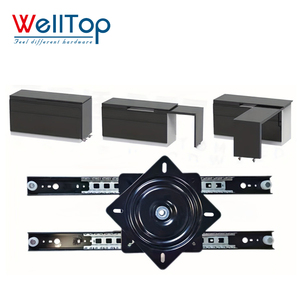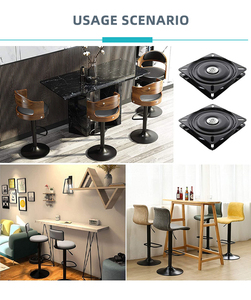(57142 products available)




























































































































































































A rotating mechanism is a device or system that enables movement in a circular or rotational manner. It allows an object to turn around an axis or pivot point. There are various types of rotating mechanisms, including:
Gear and Pinion:
The gear and pinion mechanism consist of a circular gear attached to the rotating object and a smaller pinion gear attached to a stationary base. When the pinion gear rotates, it engages with the teeth of the larger gear, causing the attached object to rotate. This mechanism can be seen in applications such as steering systems in vehicles and rotary tables.
Cam Shaft:
A camshaft is a shaft with one or more cams attached to it. A cam is an irregularly shaped disc or follower. The camshaft rotates within the engine at a constant speed. The rotating mechanism is commonly used in automotive engines to control the opening and closing of the intake and exhaust valves. As the camshaft rotates, it pushes against valve lifters or followers, causing the valves to open and close in a timed sequence.
Crank and Slider:
The crank and slider mechanism is a simple device that converts circular motion into linear motion. It consists of a rotating crank arm attached to a circular disc. This mechanism is commonly used in bicycle pedals and the connection rod in a piston engine.
Servo Motor:
Servo motors are small motors that provide precise control of angular position, acceleration, and rotational speed. They are widely used in applications requiring accurate and controlled rotation, such as robotics, CNC machinery, and aerospace systems. The rotating mechanism of a servo motor includes a DC motor, a gearbox, and a position sensor.
Slip Ring:
A slip ring is an electrical connection device that enables the transmission of power and signals between a rotating object and a stationary base. Slip rings are used in cranes, wind turbine generators, and rotating antennas. The rotating mechanism of a slip ring consists of conductive rings, brushes, and insulation material.
Universal Joint:
A universal joint (U-joint) is a mechanical coupling that connects two shafts that are not in a straight line. It allows for the transmission of torque and rotation even when the shafts are at an angle to each other. U-joints are commonly used in the drive shafts of vehicles, especially in four-wheel-drive and rear-wheel-drive cars. The rotating mechanism of a U-joint consists of two yokes and a cross-shaped spider.
Rotating mechanisms are essential components in various industries, enabling controlled rotation for different applications. Here are some key features and functions of a rotating mechanism.
Controlled Rotation
These mechanisms allow precision and control over the rotation speed and angle. For example, in robotics, the rotating mechanisms enable the precise movement of robotic arms.
Support and Stability
The rotating mechanism provides a stable base for components or objects to rotate around a point. For instance, in cameras, this mechanism supports the stable and smooth rotation of the camera lens or tripod.
Torque Transmission
It transmits torque from the motor or power source to the rotating part. This allows for the movement of the connected parts. In wind turbines, the rotating mechanism transmits torque from the rotor to the generator, converting wind energy into electricity.
Speed Regulation
Some rotating mechanisms, such as gear systems, can regulate and reduce the speed of rotation. This feature is important in applications where slow and steady movement is required, like in escalators.
Durability and Load Bearing
Rotating mechanisms are built to withstand wear and tear from continuous rotation and can support a significant amount of weight. For example, in cranes, the rotating mechanism can support heavy loads while allowing smooth and controlled rotation.
Friction Reduction
Many rotating mechanisms, such as bearings, are designed to minimize friction between moving parts. This ensures smooth and efficient rotation and reduces heat and energy loss. For example, in electric fans, bearings reduce friction and enable efficient and smooth blade rotation.
Versatility
These mechanisms can adapt to different applications and industries, from small-scale devices to large machines. For instance, in manufacturing, rotating mechanisms can be used in conveyor belts to transport materials efficiently.
Self-Alignment
Some rotating mechanisms can automatically align themselves to the center of the load, reducing wear and improving efficiency. This feature is important in applications like in mining machinery where there is a need for robust alignment under high loads.
There are many applications of rotating mechanisms in different industries. Here are some common scenarios:
Automotive Industry
Rotating mechanisms are used in various locations of vehicles. For instance, in the steering systems, rotating mechanisms transmit the rotational motion of the steering wheel to the steering knuckles. This allows drivers to control the direction of their vehicles. Rotating mechanisms are also applied in the drive shafts. These shafts transmit the engine's rotational motion to the wheels. As a result, they enable vehicles to move.
Aerospace Sector
In the aerospace sector, rotating mechanisms are commonly applied in the control surfaces of aircraft. For example, the flaps and rudders. These rotating mechanisms help to adjust the position of the control surfaces. As a result, pilots are able to control the aircraft's movement and stability.
Industrial Machinery
In industrial machines, rotating mechanisms are used to transfer motion and power between different components. For example, in conveyor belts, rotating mechanisms enable the movement of the belt and the transportation of materials.
Robotics
In the field of robotics, rotating mechanisms are applied in the robotic arms. For instance, in joints and actuators. This allows the robotic arms to perform tasks such as lifting, moving or manipulating objects. Additionally, rotating mechanisms are also used in the movement of robots by transferring power to the wheels or tracks.
Manufacturing
Rotating mechanisms are frequently used in manufacturing machines such as lathes, mills and drills. These mechanisms enable the cutting tools and workpieces to rotate appropriately for accurate shaping and drilling.
Marine Applications
In ships and boats, rotating mechanisms are used in the steering systems to control the direction of the vessel. For example, the rudder systems. They are also applied in propeller mechanisms to transmit the engine's rotational motion to the propellers and enable propulsion.
Consumer Electronics
Rotating mechanisms are commonly used in various electronic devices. For instance, in the cooling fans, they create air circulation. In the hard disk drives, they enable data storage and retrieval. Additionally, rotating mechanisms are also applied in the volume knobs for sound production control.
Medical Devices
In the medical field, rotating mechanisms are commonly applied in imaging devices such as MRI and CT scanners. Here, they enable the movement of sensors and create images of the body's internal structures. Rotating mechanisms are also applied in surgical tools like drills and saws for precise cutting and drilling.
Before buying any product in bulk, business buyers must consider some factors to determine the demand in their market. The same goes for rotating mechanisms. Here are some factors to consider before choosing a rotating mechanism for any application.
Application Requirements
Determine the application requirements. This includes load capacity, speed, precision, and environmental conditions. A rotating mechanism for a heavy-duty cart will be different from a camera rotating mechanism. Identify the parameters and choose a rotating mechanism that meets those requirements.
Gearbox and Drive System
Look at the gearbox and drive system. They come with different gear ratios and drive systems. Select a system that has the right torque output and rotational speed. Consider the efficiency and reliability of the gearbox and drive system.
Build Quality and Durability
The build quality and durability of the rotating mechanism affects its performance and lifespan. Select a mechanism that is built with high-quality materials like steel or aluminum. Consider the environmental conditions that will affect the mechanism. Choose a model that can withstand extreme temperatures and weather elements.
Maintenance Requirements
All mechanical parts need maintenance for optimum performance. Check the maintenance requirements of the rotating mechanism. This includes lubrication and cleaning. Select a mechanism that has low maintenance requirements to reduce the overall cost.
Customization Options
Some manufacturers offer customization options. This allows buyers to request for specific features that will meet their application needs. Consider the available customization options and choose the best one that meets the business demand.
Supplier Reputation
The reputation of the supplier determines the quality of the products they deliver. Check the reviews and testimonials of the suppliers before buying. Select a supplier who has a good track record in delivering quality rotating mechanisms.
Cost and Budget
All business buyers have a budget they must adhere to when buying. Look at the different prices of rotating mechanisms and their features. Select a rotating mechanism that is within the budget and offers the required features.
Q1: What are the strong and weak points of a rotating mechanism?
A1: The strong point is that it can convert linear motion to rotational motion. The weak point is that it has a limited range of motion due to the rotating mechanism's specific design, which can only rotate up to a certain angle.
Q2: How does a rotating mechanism work?
A2: The rotating mechanism works by using linear actuators to produce motion that is then converted to rotational motion using shafts, bearings, and gears.
Q3: What is the rotating mechanism called?
A3: The rotating mechanism is called motion can be translated into a desired motion using various components, such as linear actuators, shafts, bearings, and gears.